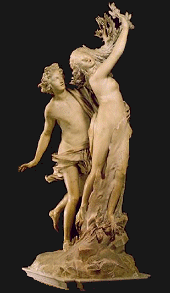 | ||
Ivy and Laurel Borders

![]() The noble laurel leaf, more commonly known as the bay leaf, has a history like no other herb. Legend and myth surrounded it even before the champions of the first Olympic games in 776 B.C. were crowned with garlands of the glossy, green leaf.
The noble laurel leaf, more commonly known as the bay leaf, has a history like no other herb. Legend and myth surrounded it even before the champions of the first Olympic games in 776 B.C. were crowned with garlands of the glossy, green leaf.
In Greek mythology, Daphne was the young, beautiful daughter of a river god. She was pursued by many admirers but she rejected every lover, including the powerful son of Zeus, Apollo (god of prophecy, of musical and artistic inspiration, of archers and of healing). When Apollo persisted in his quest for her love, Daphne became frightened and prayed to the gods for mercy, whereupon she was transformed into a laurel tree. Apollo then took from her branches and made a wreath as a memory of her beauty and his love for her. He appropriated the laurel wreath, since called "daphne" in Greek, for champions and those who strived for excellence in their chosen fields, i.e. in the ancient Olympics games, the champions were crowned with a "daphne".
Romans considered the bay tree a symbol of glory as well as protection from thunderstorms. Nero believed bay trees purified the air and Roman victors would wipe the blood from their swords with the leaves. In Shakespeare's time, superstition held that when bay trees died, disaster was sure to follow.
Today the bay leaf is used around the world for culinary purposes. It is picked by hand from the evergreen Laurus nobilis or bay tree native to the Mediterranean. The trees will grow to heights of 60 feet with thick, shiny leaves. Thin layers of leaves are weighted down, to prevent curling, and dried in the shade. Drying in the sun causes them to turn brown and lose much of their essential oil.
The most common form of bay leaf as an herb is the dried whole leaf. It may be crumbled into recipes or added whole. Should you find fresh leaves, remember that they will be slightly more bitter than the dried version. Although rather difficult to find, ground bay leaves are convenient to use and excellent for creating your own spice blends.
Image Blend JavaScript
![]()
![]() Image Blend JavaScript written by Jeff of The Hunting Ground, an ideal site to learn the concepts of HTML, CSS, JavaScript and DHTML. The variety of categories have examples of what can be achieved, from creating a simple pop-up to the more dynamic effects of DHTML. Hundreds of unique and original JavaScripts available.
Image Blend JavaScript written by Jeff of The Hunting Ground, an ideal site to learn the concepts of HTML, CSS, JavaScript and DHTML. The variety of categories have examples of what can be achieved, from creating a simple pop-up to the more dynamic effects of DHTML. Hundreds of unique and original JavaScripts available.
Download the Images to Your Hard Drive
Internet Explorer Users on PC![]()
On the preview page, right-click on the image and select "Save Background As" or click the "Download" link under each thumbnail to save the image in a zipped file.![]()
All Other Browsers and Platforms![]()
Click the "Download" link under each thumbnail to save the image in a zipped file.
Linking Back
If you use any of the images on your web site, please give something back by linking to The Inspiration Gallery. Refer to the Terms of Use as to how you can make the buttons blend better with your site's colour scheme.
| 48 Ivy and Laurel Borders • 16 Co-Ordinating Backgrounds | Page 1 of 1 |
Click here to view ivy wallpaper patterns.















































